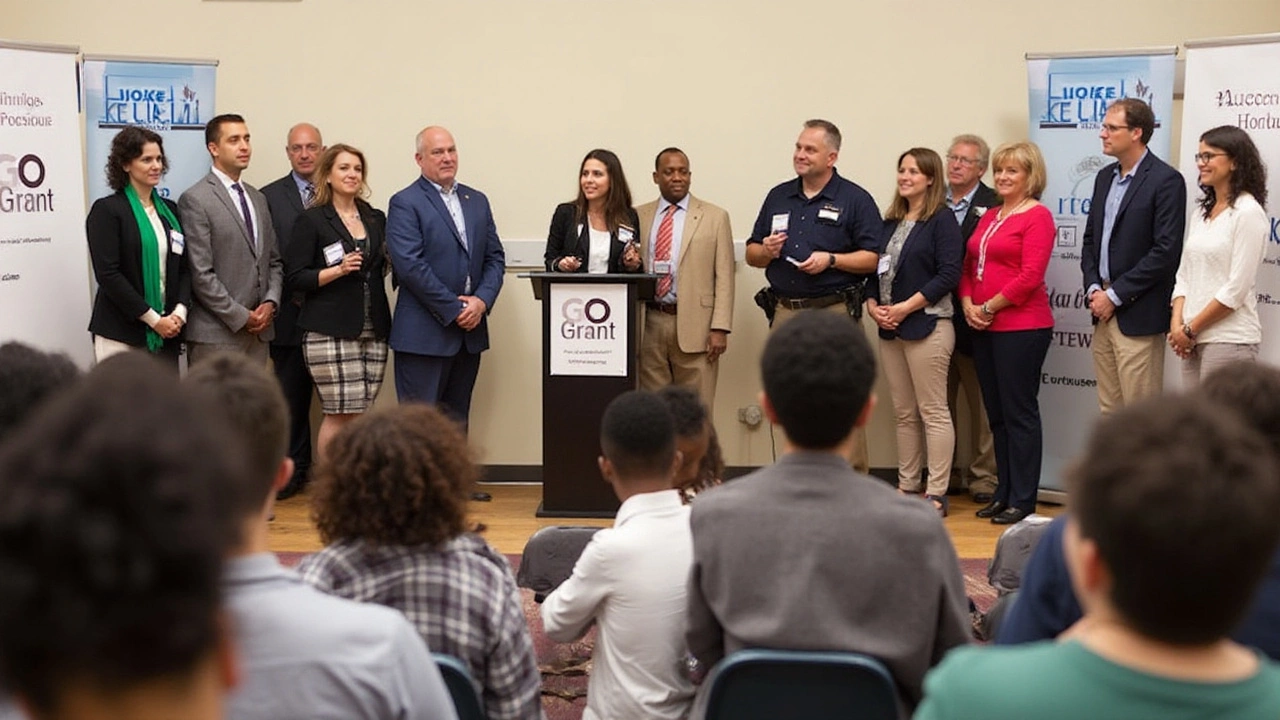The Go Grant initiative in Arkansas stands as a beacon of hope for individuals and organizations dedicated to tackling homelessness. Established with the aim of providing financial assistance to homeless shelters, this program plays a crucial role in ensuring the vulnerable populations of Arkansas have a safe place to call home.
Whether you're an organization seeking funding or a community member curious about the impact of state resources, understanding the Go Grant can be immensely beneficial. It is crucial for potential applicants to familiarize themselves with the eligibility criteria and requirements to make the most of this opportunity.
- Introduction to the Go Grant
- Eligibility Criteria and Requirements
- Applying for the Go Grant
- Impact on Homeless Shelters
- Success Stories and Testimonials
- Tips for Maximizing the Grant
Introduction to the Go Grant
In the heart of Arkansas, the Go Grant represents a critical lifeline in the ongoing fight against homelessness. This grant is a pivotal state-sponsored program meticulously designed to funnel resources directly into the hands of those who manage homeless shelters and housing initiatives across the region. Launched in response to rising homelessness rates and the increasing demand on existing shelters, the Go Grant underscores the state's commitment to ensuring every resident has access to safe, reliable housing.
The origins of the Go Grant can be traced back to collaborative efforts between state officials, local governments, and non-profit organizations, all united under a common goal: to eradicate homelessness by providing sustainable financial support. What makes this program particularly impactful is its flexibility; funds can be employed not only for immediate assistance but also for long-term solutions that focus on prevention and integration of individuals back into the community. This approach reflects a growing understanding that addressing homelessness requires both immediate and strategic actions.
According to a 2023 collaborative report by the Arkansas Interagency Council on Homelessness, the Go Grant has contributed significantly to reducing the state's homeless population by nearly 15% since its inception. Such achievements highlight the profound influence of targeted financial assistance in remedying systemic challenges.
"The Go Grant isn't just a financial aid; it's a statement of our community's values. It shows our dedication to ensuring everyone in Arkansas has a chance to secure stable housing," said one local shelter coordinator in a recent interview.
The Go Grant's impact extends beyond the walls of shelters. Recipients of this aid are encouraged to engage in innovative practices that not only address current homelessness but also prevent future occurrences. This includes initiatives such as job training programs, mental health services, and affordable housing developments. By creating a holistic support network, the state aims to provide individuals with the tools necessary for lasting independence and well-being.
One key aspect that often attracts organizations to apply for the Go Grant is its comprehensive application process. While the requirements are stringent to ensure proper allocation of resources, the process is designed to be inclusive, welcoming both seasoned non-profits and emerging community groups. Potential applicants are advised to present detailed proposals that outline their intended use of funds and their anticipated impact. This transparency is crucial, as it builds trust with the grant administrators and demonstrates a commitment to accountability and effective utilization of the resources provided.
In summary, the Go Grant stands as a testament to the power of targeted intervention. It not only provides essential funding to homeless shelters but also instills hope within communities that a significant reduction in homelessness is both achievable and sustainable. If you're considering applying for the Go Grant, keep in mind the dual emphasis on immediate relief and long-term solutions—two pillars that form the foundation of this impactful program.
Eligibility Criteria and Requirements
The Arkansas Go Grant is a promising initiative designed to support organizations focused on alleviating homelessness across the state. However, not every applicant may qualify, as the program has specific requirements and criteria to ensure the funds are allocated effectively. The primary objective is to identify and enhance the capabilities of organizations that are committed to providing shelter and services to those in need, ensuring they can run consistently and sustainably.
To start, applicants of the Go Grant must be legally recognized entities, often needing to provide proof of their status as a non-profit organization. Entities seeking to apply need to demonstrate that they are directly involved in providing shelter services to homeless individuals. Additionally, a detailed plan of how the funds will be utilized must be submitted. This plan should include a breakdown of costs, projected outcomes, and the reach of the services rendered. Typically, organizations must also illustrate previous success stories or outline the effectiveness of past projects to convince stakeholders of their capability to manage grant funds wisely.
A vital aspect of the eligibility process involves meeting specific financial parameters. Applicants need to showcase transparency in their financial operations, often requiring accustomed audits or financial reviews to confirm their financial standing. The program also considers regional needs and may prioritize applications from areas with heightened homelessness rates, thereby striving to allocate resources where they are most urgently needed. Furthermore, organizations are also required to commit to ongoing evaluation and reporting. Regular reports are necessary to ensure the program remains accountable and that the funds are bringing about the intended impact.
Key Eligibility Aspects
During the application review process, a key aspect might include evaluating the strategic plans of the applicant organizations. This review focuses on the initiatives' innovative approaches to tackle homelessness, as innovation can often lead to more effective solutions. Diversity of services offered by organizations is also examined, as multi-faceted programs may provide more comprehensive support to those in need. For instance, in a recent survey highlighted by the Homelessness Research Institute, integrated programs that combine housing with health care and job training services result in significant positive outcomes for beneficiaries. Such integrated services may add weight to an application. "Ensuring diverse services increases the chances that individuals can find and maintain stable housing," noted Emma Green, director of an acclaimed Arkansas-based shelter.
Beyond these critical facets, it's also imperative that applicants adhere to deadlines and meticulously prepare their application materials. Applications should encapsulate the unique mission of the organization while emphasizing alignment with the broader objectives of the Go Grant. It is this alignment that often plays a critical role in determining grant receipt. As the demand for shelter services is on a steady rise, the Go Grant takes steps towards instilling hope across the landscape of Arkansas. Aspiring applicants are encouraged to focus on building a case that not only answers the immediate shelter needs but also contributes to long-term stability and transformation of the homeless community. Finally, staying updated on any changes to criteria ensures an organization's ability to apply successfully in subsequent cycles.

Applying for the Go Grant
Embarking on the process of applying for the Go Grant in Arkansas is a critical step for organizations aiming to make a significant impact on their community's homelessness issues. The procedure is structured, designed to ensure that the funds reach the shelters and initiatives that most need them. As a starting point, prospective applicants need to ensure they meet the established eligibility criteria, which includes being a registered non-profit organization dedicated to providing housing assistance or emergency shelter services.
Applicants are encouraged to submit a detailed proposal outlining the specific needs of their organization and how the grant funds will be utilized. This proposal should include comprehensive data on the number of individuals served annually, past successes, and projected outcomes if awarded the grant. A well-drafted proposal not only showcases the organization's capabilities but also aligns with the grant's objectives.
The application process is competitive, and attention to detail can make a significant difference. It is vital for applicants to adhere strictly to deadlines and submission guidelines outlined by the state's funding agency. Missing deadlines can result in disqualification, no matter how deserving the project might be. To aid in preparation, potential applicants might attend workshops or seek advice from previous beneficiaries who have navigated this process successfully.
Request for Proposals (RFPs)
Request for Proposals (RFPs) are periodically announced by the state, inviting organizations to apply for the Arkansas Go Grant. Staying informed about these announcements is crucial. RFPs often contain specifics regarding the year’s priorities, target areas for improvement, and any new regulations applicants must comply with. For example, a recent RFP emphasized the integration of mental health services within shelter operations, reflecting evolving state priorities.
“Applying for funding can be daunting. However, those who articulate a clear mission and demonstrate measurable impact often find success,” shares Julia Hart, Director of Hope Arkansas, a previous grant recipient.
Organizations should also be prepared for a potential site visit or interview during the review process, providing an opportunity to discuss their application further and underscore their passion and readiness to utilize the grant effectively. This interaction can often provide an edge, allowing applicants to personally connect with decision-makers and highlight unique aspects of their organization not conveyed in writing.
A noteworthy element of the application process is collaboration between agencies. Evidence of partnerships with other local service providers can strengthen an application, demonstrating a community-based approach to tackling homelessness. Such collaborations can extend the reach of the grant’s impact, promoting synergy in addressing multiple facets of housing instability.
It is estimated that, through the effective application and utilization of the Go Grant, over 5,000 individuals have been provided with shelter assistance annually across the state of Arkansas. This statistic not only highlights the critical role of the grant in supporting shelters but also underscores the importance of a meticulous application process to secure funding.
Impact on Homeless Shelters
The Go Grant program in Arkansas has truly transformed the landscape of homeless assistance, breathing new life into shelters that serve the state's unhoused population. The funding provided through this grant allows shelters to expand their capacity, upgrade facilities, and improve the services they offer to those in need. Many shelters have reported a significant increase in their ability to accommodate more individuals and families, contributing positively to their communities.
Before the introduction of the Go Grant, numerous shelters operated on shoestring budgets, often forced to turn people away due to lack of space or resources. Now, with this financial support, shelters can better accommodate the growing demand. A notable example includes the additional beds and increased staffing in facilities, which enables more comprehensive care for residents. The Go Grant also fosters innovation within shelters, encouraging them to adopt new programs that can help residents transition to stable housing solutions successfully.
A recent survey indicated that shelters receiving the Go Grant experienced a 25% decrease in resident turnover rates, attributed to enhanced programs that focus on skill training and job placement.
The director of a local shelter noted, "The Go Grant has been a game-changer for us. It has not only given us the means to offer more beds but also the ability to implement programs that change lives permanently."Such programs aim to break the cycle of homelessness by equipping residents with the necessary tools to reintegrate into society.
Additionally, the grant has allowed shelters to invest in specialty services such as mental health support and substance abuse counseling, addressing the diverse needs of their residents holistically. By providing a more well-rounded approach to assistance, shelters have witnessed significant improvements in resident wellbeing and future prospects. This comprehensive strategy is essential because the path to sustainable living often involves more than just shelter; it requires targeted support and resources tailored to individuals' unique challenges.
Beyond the immediate enhancements, funding from the Go Grant promotes long-term strategic planning within shelters. With this newfound financial stability, organizations can engage in multi-year planning, setting ambitious goals that stretch beyond short-term crisis management. Engaging strategic partnerships is another significant benefit, as shelters can collaborate with various community organizations to strengthen their support network and ensure a more robust safety net for residents.
Ultimately, the Arkansas Go Grant stands as a cornerstone of hope and recovery within the homeless shelter community, reshaping the way these vital organizations operate and continue their essential mission. By enabling shelters to expand and refine their services, the grant not only supports current residents but also lays the groundwork for systemic changes that will support individuals and families for years to come. The collective positive outcomes seen across different shelters highlight the profound impact of having a dedicated funding source focused on eradicating homelessness in Arkansas.

Success Stories and Testimonials
Delving into the myriad of heartwarming success stories and testimonials from beneficiaries of the Arkansas Go Grant initiative reveals the profound impact funding can have on transforming lives. At the heart of downtown Little Rock, a non-profit organization named Haven House has flourished thanks to Go Grant support. This shelter provides more than just temporary housing; it offers comprehensive rehabilitation programs aiming to reintegrate individuals back into society. In 2024, Haven House reported a remarkable 30% increase in its capacity to house residents overnight. This was directly attributed to the funds received through the Go Grant, enabling them to not only expand their existing facilities but also to enhance their support services. One resident, Emily, shared her emotional journey from the streets to stable employment. "The warmth and encouragement I received at Haven House rekindled my hope. Knowing that there was a bed for me every night was a turning point." The success of Haven House is a testament to how targeted funding initiatives can empower communities and spearhead positive change.
The impact of the Go Grant goes beyond just creating infrastructure. At another shelter, Elm Street Sanctuary, the grant enabled the development of a comprehensive job training program. This initiative sought to not only provide skills but to inspire confidence among its participants. Since its inception, the program has boasted a staggering success rate, with over 75% of participants securing jobs within six months of completing the course. Yet another example is the story of John, an Army veteran who found refuge and renewal at Elm Street Sanctuary. John's story is a powerful testimonial to resilience and the potential for transformation when adequate resources are mobilized. His success in securing a stable job and reuniting with his family is a source of inspiration for many. These personal victories underpin the effectiveness of the Go Grant in fostering environments where individuals can thrive against odds.
Meanwhile, in Northwest Arkansas, the Harmony Home Project celebrated a notable milestone: its 500th successful reintegration case. By adopting a holistic approach to combating homelessness, they have not only relied on Go Grant funds to increase shelter availability but have implemented arts and crafts therapy as part of their rehabilitation process. Testimonials from participants highlight the transformative nature of these programs; they not only provide a roof over people's heads but also instill a sense of purpose and belonging. Art classes and workshops have been credited with boosting morale and self-worth among residents. A survey conducted by Harmony Home post-rehabilitation indicated a significant rise in participants' self-esteem levels. Such results shine a light on the importance of creativity and community in recovery and underscore the pivotal role of the Go Grant in fostering such innovative support solutions.
Additionally, the grant's ramifications are felt on a personal level, echoing throughout Arkansas. Drawing from an insightful analysis, a regional committee reported that the Go Grant requires shelters to maintain transparency regarding fund allocation and results. This ensures accountability and engenders trust from both public and private stakeholders. The Fargo Center, a recipient of the grant, documented a detailed account of its expenditures, showcasing investments in renewable energy solutions to power their facility sustainably. This innovative use of funds aligns with broader state initiatives on environmental sustainability, demonstrating that the Go Grant is adaptable and forward-thinking. As part of their report, they included compelling data that indicated a marked decrease in utility costs. By setting such examples, the Fargo Center inspires other foundations to integrate eco-friendly solutions into their operations, creating a more resilient ecosystem for shelter support.
Beyond the numbers and impressive statistics, what truly stands out are the stories of courage that each grant recipient shares. These narratives of recovery and resilience indicate the potential of well-placed financial aid to make meaningful differences in people's lives. Organizations and individuals alike echo a consensus on the Go Grant's essential role: it serves as a catalyst for lasting change that goes well beyond brick-and-mortar improvements. An important lesson learned through these testimonies is that effective financial aid doesn't just provide temporary relief, but, when harnessed correctly, can pave pathways towards sustainable and enduring personal growth.
Tips for Maximizing the Grant
When it comes to effectively utilizing the Arkansas Go Grant, a well-planned strategy can make all the difference. Whether you're running an established homeless shelter or a new program, navigating the intricacies of grant management requires a blend of insight, foresight, and practical actions. First and foremost, familiarize yourself with the specific goals and priorities of the Go Grant. A keen understanding of what the grant aims to achieve can guide you in aligning your project objectives accordingly. Review the detailed guidelines provided by the granting body and identify any key areas where your initiative can excel. The closer your proposal matches the intent of the grant, the stronger your application will be.
Efficiency is another crucial factor. Streamlining your operations can free up valuable resources, allowing your organization to direct more time and energy toward fulfilling the grant objectives. Consider investing in technology that simplifies tasks such as data collection and reporting, which are often required by funding bodies. Timely submissions of all required documentation can't be stressed enough; missing deadlines or providing incomplete information can jeopardize your chances of receiving or maintaining funds. Drawing from the expertise of seasoned grant managers can offer new perspectives and approaches you may not have previously considered. Engage with experts who can offer insights into successfully managing and spending grants efficiently, thus ensuring compliance with funding stipulations.
Building strong partnerships within the community can provide a significant advantage. Collaboration can not only share the financial burden but also bring different skills and resources to the table, enriching your program's offerings. Local businesses, other non-profits, and even residents can become vital allies, contributing unique strengths to your mission of combating homelessness. It’s crucial to constantly evaluate and reassess your project plans. Adaptability allows you to respond proactively to changing needs in your shelter or community, ensuring that your project remains relevant and impactful as time goes on. Engaging with your benefactors—those you aim to help—can provide firsthand insights into what measures and initiatives hold true potential for positive change.
A meticulous approach to budgeting cannot be ignored. Itemize all expected expenditures and periodically review them against current spendings to ensure there are no discrepancies. This might involve routine adjustments as unforeseen expenses can arise, but with a strong budgetary foundation, most challenges can be managed smoothly. Transparency not only improves trust with grant providers but also strengthens the community's support. Sharing success stories and outcomes, complete with data and testimonies, heightens the intangible benefits and reputation of your shelter within Arkansas.
Learning from past experiences is critical. Reflect on what has previously been effective or less successful and incorporate these insights into your current plan. Feedback from both staff and beneficiaries can be invaluable, granting a dual perspective of both operational efficiency and quality of service delivery. Stay informed about changes in policies or guidelines related to the Go Grant. Engage with networks and forums that discuss homelessness and shelter funding to stay current on best practices and upcoming opportunities.
Remember, maximizing the potential of the Arkansas Go Grant is as much an art as it is a science. By reflecting on what's possible and remaining open to new methods and ideas, your organization can utilize this funding not only as a resource but as a catalyst for transformative change within your community. It's about making every dollar count towards the shared goal of securing safe housing for Arkansas’s homeless population.





